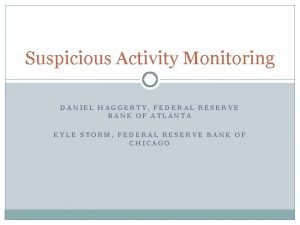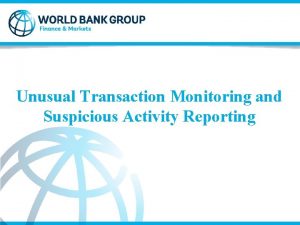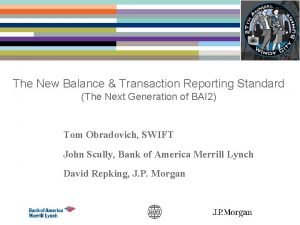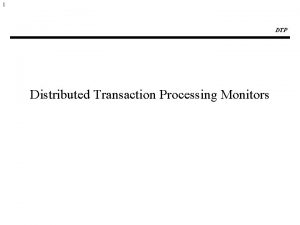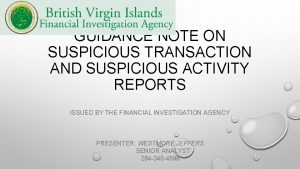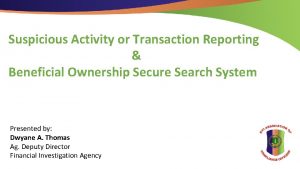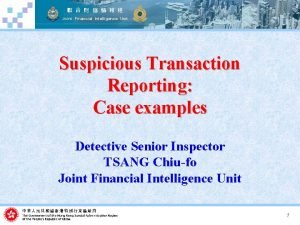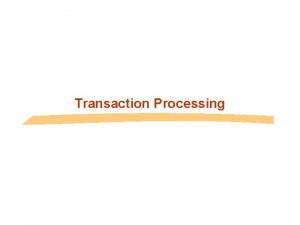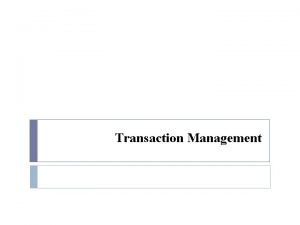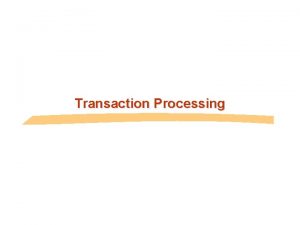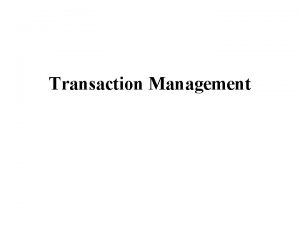Unusual Transaction Monitoring and Suspicious Activity Reporting Unusual












- Slides: 12

Unusual Transaction Monitoring and Suspicious Activity Reporting

Unusual Transactions Monitoring • Skill: professional financial expertise & experience necessary ! • Know the client • Transaction monitoring Ø Examine background & purpose to large, complex or unusual transaction patterns • Monitoring criteria Ø Regularly improved & updated • Suspicious and Unusual findings Ø Transaction Activity, Business and Account Structures, Client Vetting Results, High Risk Clients. 2

Transaction Activity • Suspicious activity? : Ø Ø Ø Ø Structuring to avoid reporting requirements or detection Rapid movement of funds Transactions out of context with client’s “expected” activity Unexplained complexity No clear economic purpose Domestic clients performing international transactions Transactions involving high risk countries 3

Business and Account Structures • Business or Entity Ø Ø Ø Ø Lack of transparency ü Beneficial ownership Overly complex or difficult to understand Special purpose vehicles or entities Foreign Business Entities ü International Business Corporations ü Private Investment Companies Bearer shares Shell company or FIs Nominees • Account Ø Unexplained accountholders and transactors 4

Client Vetting Results • Items that may cause concern Ø Ø Unverified or inconsistent ID data points Incomplete FI data or files Negative news search findings Legal issues § Court filings, arrests, warrants, convictions Ø Established clients vs. walk-ins Ø High risk clients and geographies 5

High Risk Clients • Who are the high risk clients ? • How are they flagged? (Manual vs. system) • New account approval • Risk Ratings • Impact on monitoring • Periodic reviews 6

Reporting of Suspicious Transactions (1/2) • Mandatory reporting of suspicious transactions to FIU • Report funds related to terrorism • All suspicious transactions, including attempted transactions, should be reported regardless of the amount of the transaction. 7

Reporting of Suspicious Transactions (2/2) • FIs and their directors, officers and employees should be ü Prohibited by law from disclosing (tipping off) the fact that a STR or related information is being reported/provided to the FIU, ü Protected by law from both criminal and civil liability. • Protection should be available even if they did not know precisely what the underlying criminal activity was, and regardless of whether illegal activity actually occurred. 8

STR Record Retention • FIs must retain copies of STRs and supporting documentation for five years -at least- from the date of filing the STR, • FIs must provide all documentation supporting the filing of a STR upon request by ü Related supervisors, ü Financial Intelligence Unit, ü Appropriate Law Enforcement Agencies. • “Supporting documentation” refers to all documents or records that assisted an FI in making the determination that certain activity required a STR filing. 9

Assessing the Quality of STRs A supervisor should assess whether; STRs contain accurate information. STR forms filed timely and include all known subject information STR narratives are complete and thoroughly describe, and clearly explain why the activity is suspicious. To make the law enforcement clearly understand the described conduct and its possible criminal nature 10

Evaluating the STR Decision Making Process Supervisors assess whether; ü FI has policies, procedures, and processes for referring unusual activity from all business lines to the personnel or department responsible for evaluating unusual activity, ü Management established a clear and defined escalation process from the point of initial detection to disposition of the investigation, ü The decision maker, whether an individual or committee, has the authority to make the final STR filing decision, ü There is a defined process to resolve differences of opinion on filing decisions if the FI uses a committee, ü FI documents STR decisions, including the specific reason for filing or not filing a STR. 11

Q&A
 Suspicious activity monitoring
Suspicious activity monitoring Unusual transactions
Unusual transactions Balance and transaction reporting
Balance and transaction reporting Transaction process monitoring tpm
Transaction process monitoring tpm Palo alto suspicious dns query
Palo alto suspicious dns query Suspicious mail training
Suspicious mail training Birads lexicon
Birads lexicon Beetle blade maze runner
Beetle blade maze runner In literature, an author's tone can be revealed by _____.
In literature, an author's tone can be revealed by _____. Suspicious mail handling
Suspicious mail handling How to deal with suspicious customers
How to deal with suspicious customers Option hacker keene
Option hacker keene Hobbies types
Hobbies types
